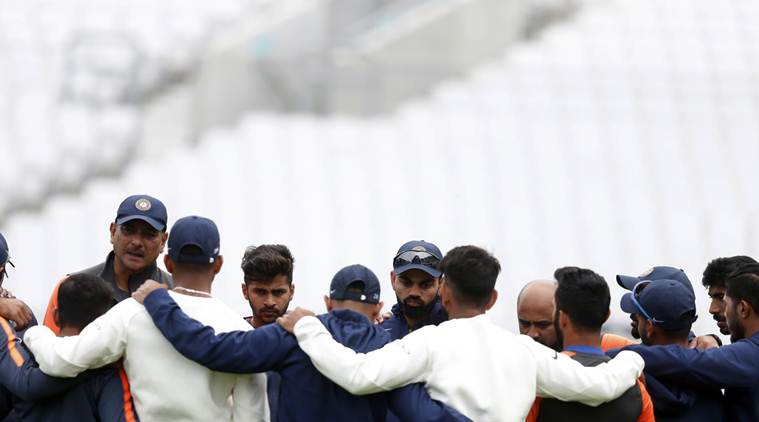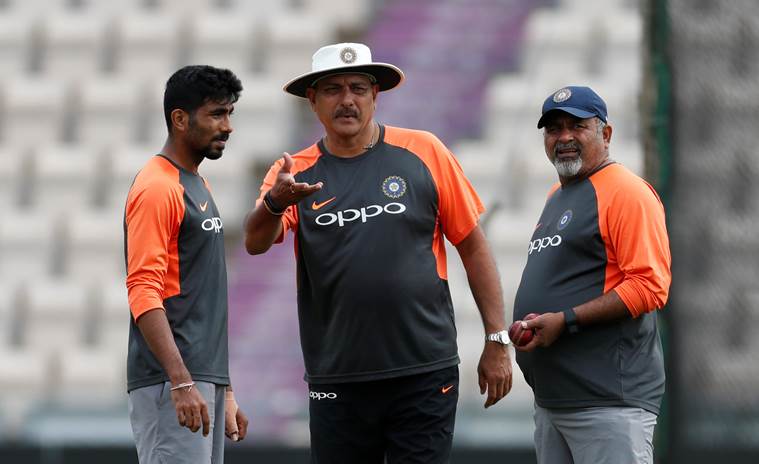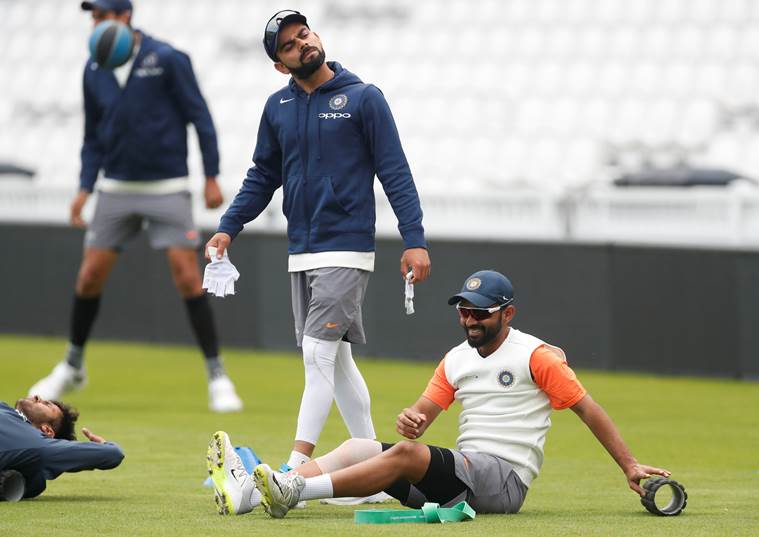 India coach Ravi Shastri speaks to the team during a practice session at the Oval on Wednesday. India go into the final Test against England having already lost the five-match series. (Source: AP)
India coach Ravi Shastri speaks to the team during a practice session at the Oval on Wednesday. India go into the final Test against England having already lost the five-match series. (Source: AP)
At one point in the tour, a senior member of the management dwelt on Virat Kohli’s style of leadership. “You guys don’t realise the energy he brings on the field. It’s so infectious, it charges the team — this is a young team and he knows the pulse. You can say he can get better with tactics but that would come with time. Which captain was a ready-made product? Kohli cares and wants to improve. Which captain has come out and said openly that he wants to win overseas. He knows he will be judged on that and more importantly, he wants to be judged on that. He wants to make this team world beaters.”
All probably accurate observations but when you lose a series against a team that has lost Tests to Sri Lanka and Pakistan in the recent past, something somewhere is not going right.
The frequent chopping and changing by Kohli and Ravi Shastri has left residues of self-doubt in the team. “It would have been better if they had said at the start of the tour, ‘guys, we will go with the same team for the first three Tests. Do your best.’ That gives a different kind of confidence. Kohli is a good man and wants the best for the team and doesn’t mean to create it but the changes make you doubt yourself. It’s our mistake to feel like that probably but we are humans,” says a player.
If not self-doubt, a dent in confidence at least which then results in a crab mentality. Players, “humans after all”, start fretting about their spot: breeding insecurity as a performance-enhancing drug isn’t ideal. Especially among a group of young players. It might work when you want to cut down egos in the team, to keep them on their toes, but not apt for this band of men.
It also leads players into unpleasant mental states. Even senior players. “You start to second guess. Kyun aisey kar rahe hain? You then start feeling you are on your own here,” says a player. At times, the situation gets almost comical. A senior player texted his agent friend to enquire what was said about him at the press conference. It was actually laudatory, but the fact that he had to seek validation tells a story of its own.
Micro vs macro
 Players in private talk about the suggestions Ravi Shastri makes and how it has helped them. (Source: Reuters)
Players in private talk about the suggestions Ravi Shastri makes and how it has helped them. (Source: Reuters)
There has been much speculation about the influence of Shastri and others on the team. It’s not as if Shastri doesn’t do much. Even technically, he contributes. Without him, perhaps Kohli wouldn’t have made the important little changes he has. At the nets, across grounds here, one has seen him being fully involved. He would even stand close to batsmen and tell them to get upright in their stance and explain to them the rationale behind it. He would check their stance, suggest them to open up and stuff like that. Players in private talk about the suggestions he makes and how it has helped them. But it’s the macro picture that puts the doubts. Why is he allowing so many changes? What does he really think of us, deep inside? Is he disappointed that we aren’t showing as much guts and heart as he wants us to? But how can we when we aren’t sure about our places.
Sometimes, a captain has to do what is needed, even if some players don’t like it. He needs to talk to his players more often. Kohli prides himself on his communication skills and in fact, at the start of his captaincy, R Ashwin went on record to say that the difference between MS Dhoni and Kohli was in the way they communicated. How sometimes you didn’t know where you stood with Dhoni and what he really thought, but how Kohli makes a point to communicate. He even called Kohli a “generation-changing player” . He needs to get back to those days again. Clear communication about the dropping or positions and roles in the team. This applies to both Kohli and Shastri.
You put this to a member of the support staff and he dashes it: “Honestly, I haven’t seen a more open and communicative leadership group than these two-three people. They always say what they feel and you must realise sometimes because of their own insecurities, players can say stuff.” Of course, that’s a given. There is no ideal way to lead, you can’t please everyone but it’s time that the leadership accepts that the frequent chops do trigger doubts.
Sometimes, the fault does lie with the players. One player said he didn’t want to be talking cricket after 6 pm and would rather do his own thing. It would have been understandable if it was the other way around — if the leadership wasn’t interested, but you can’t accuse them of talking cricket. If you are not willing to listen to Shastri on how he tackled Holding and Co. or whatever was said, and draw inspiration from that, then the problem lies inside.
Just to present the immense difficulties in running a cricket team, here is another view presented by a player. This is about the bowling plans. The Indian attack has been really good but this senior player believes the planning could have been more meticulous.
“Before the start of the series, it was clear to me that England’s lower-middle order is its strength. You might get their top out but they will fight later. In nearly every game, we let the lower-middle order to score.”
So why did this happen? Isn’t it one of those things that always happens in a game of cricket? Someone is bound to put a partnership or two? “I got the feeling that when we took the first four wickets cheaply, there was a feeling as if the job was over. We had crushed them. Bit more discipline and proper planning and focus would have been better.” Hmm.
Fear and insecurity
 History has shown that a stable team breeds a kind of atmosphere that the leadership craves for: not much insecurity, eagerness to partake in the common team goal, and the ability to put the team over oneself. (Source: Reuters)
History has shown that a stable team breeds a kind of atmosphere that the leadership craves for: not much insecurity, eagerness to partake in the common team goal, and the ability to put the team over oneself. (Source: Reuters)
One thing is clear amidst all this: you can argue about a tactic or strategy or need for more detailed planning, but there is no doubt that the frequent changes have left an unpleasant aftertaste in the team. Just as he trusts himself as a batsman to adapt and be flexible, Kohli needs to extend that courtesy to his team-mates. History has shown that a stable team breeds a kind of atmosphere that the leadership craves for: not much insecurity, eagerness to partake in the common team goal, and the ability to put the team over oneself. Of course, the danger is going overboard so much that a coterie develops and complacency settles in. But alert leadership can nip that in the bud and anyway, that takes years to kick in.
However, it’s easy to pin all the blame on the leadership group and totally neglect the role of others. How many of the players made the necessary changes required to succeed in England? The ones who did improve, those who didn’t fell. Could you have imagined Shastri going down tamely without a fight in a similar situation as a player? He would have tried something: stood outside the crease, stood around off stump, he would have done something, anything, to gain a competitive advantage.
Those who tried to adapt succeeded, the rest fell tamely. KL Rahul has just kept batting the same way: stuck at the crease. Considering Shikhar Dhawan made the changes in the last two Tests — playing late, letting the ball come to him, slowing down the bat-swing — it would perhaps be prudent to reward him for those efforts and retain him. And bring in Prithvi Shaw for Rahul for the Oval Test. As an opportunity to the kid and a message to Rahul.
M Vijay should have done better. He has the game, the cricketing intelligence, the heart and mental fortitude, but didn’t change much. Cheteshwar Pujara made the necessary changes required to succeed here: stand taller at the stance, more upright, and tuck that right elbow in to not push out at deliveries. All that effort paid off.
What can you say about Ashwin? A spectacular performance in the first Test when not many expected. Then whispers of injury, body stiffness, groin trouble – and he couldn’t do as much as he should have on the third day of the fourth Test. And that reverse-sweep in the first innings when the Test was in the balance. It made Sanjay Bangar, who usually protects his players and hardly says anything in public, make unprovoked comments. No one asked him about Ashwin but he made a point to say that the shot wasn’t on. Nothing bad about what he said, but he usually doesn’t say stuff like that. And it made you go, ‘hmm’.
The problem with Hardik Pandya is that his game isn’t as good as he thinks it is. It’s clear he is evolving and improving, and to be successful he has to ignore criticisms like this and carry on doing what he is doing. Self-doubt isn’t the answer but a bit more self-awareness can’t hurt. For example, his defensive game still needs lot of work: often, he gets squared up to deliveries which he shouldn’t be. It will perhaps be prudent if mixes up his defence with more attacking options, as of now.
Early on in the series, a member of the management put across his wish list: “We need openers, a strong middle-order batsman, and a pacer. Don’t even say all-rounder as we know there is no one in the country now.” They also need a bit more clarity of thought, a sense of dare that can inspire them to seize the moment when the game is in the balance and not shrink away like they have been doing. It’s up to Kohli and Shastri now to find ways to inspire them to make that switch. More importantly, it has to come from within. Both are clichés — the captain inspiring and the fire in individual bellies of others, but sport is all about making clichés ring true.